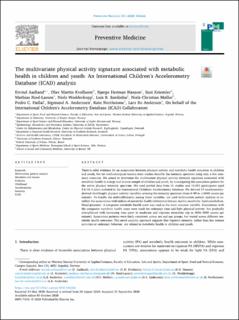| dc.contributor.author | Aadland, Eivind | |
| dc.contributor.author | Kvalheim, Olav Martin | |
| dc.contributor.author | Hansen, Bjørge Hermann | |
| dc.contributor.author | Kriemler, Susi | |
| dc.contributor.author | Ried-Larsen, Mathias | |
| dc.contributor.author | Wedderkopp, Niels | |
| dc.contributor.author | Sardinha, Luis B. | |
| dc.contributor.author | Møller, Niels Christian | |
| dc.contributor.author | Hallal, Pedro C. | |
| dc.contributor.author | Anderssen, Sigmund Alfred | |
| dc.contributor.author | Northstone, Kate | |
| dc.contributor.author | Andersen, Lars Bo | |
| dc.date.accessioned | 2021-04-27T11:25:56Z | |
| dc.date.available | 2021-04-27T11:25:56Z | |
| dc.date.created | 2020-10-09T13:58:11Z | |
| dc.date.issued | 2020 | |
| dc.Published | Preventive Medicine. 2020, 141:106266 1-8. | |
| dc.identifier.issn | 0091-7435 | |
| dc.identifier.uri | https://hdl.handle.net/11250/2739903 | |
| dc.description.abstract | There is solid evidence for an association between physical activity and metabolic health outcomes in children and youth, but for methodological reasons most studies describe the intensity spectrum using only a few summary measures. We aimed to determine the multivariate physical activity intensity signature associated with metabolic health in a large and diverse sample of children and youth, by investigating the association pattern for the entire physical intensity spectrum. We used pooled data from 11 studies and 11,853 participants aged 5.8–18.4 years included in the International Children's Accelerometry Database. We derived 14 accelerometry-derived (ActiGraph) physical activity variables covering the intensity spectrum (from 0–99 to ≥8000 counts per minute). To handle the multicollinearity among these variables, we used multivariate pattern analysis to establish the associations with indices of metabolic health (abdominal fatness, insulin sensitivity, lipid metabolism, blood pressure). A composite metabolic health score was used as the main outcome variable. Associations with the composite metabolic health score were weak for sedentary time and light physical activity, but gradually strengthened with increasing time spent in moderate and vigorous intensities (up to 4000–5000 counts per minute). Association patterns were fairly consistent across sex and age groups, but varied across different metabolic health outcomes. This novel analytic approach suggests that vigorous intensity, rather than less intense activities or sedentary behavior, are related to metabolic health in children and youth. | en_US |
| dc.language.iso | eng | en_US |
| dc.publisher | Elsevier | en_US |
| dc.rights | Navngivelse 4.0 Internasjonal | * |
| dc.rights.uri | http://creativecommons.org/licenses/by/4.0/deed.no | * |
| dc.title | The multivariate physical activity signature associated with metabolic health in children and youth: An International Children's Accelerometry Database (ICAD) analysis | en_US |
| dc.type | Journal article | en_US |
| dc.type | Peer reviewed | en_US |
| dc.description.version | publishedVersion | en_US |
| dc.rights.holder | Copyright 2020 The Authors. | en_US |
| dc.source.articlenumber | 106266 | en_US |
| cristin.ispublished | true | |
| cristin.fulltext | original | |
| cristin.qualitycode | 2 | |
| dc.identifier.doi | 10.1016/j.ypmed.2020.106266 | |
| dc.identifier.cristin | 1838497 | |
| dc.source.journal | Preventive Medicine | en_US |
| dc.source.40 | 141:106266 | |
| dc.identifier.citation | Preventive Medicine. 2020, 141, 106266 | en_US |
| dc.source.volume | 141 | en_US |

